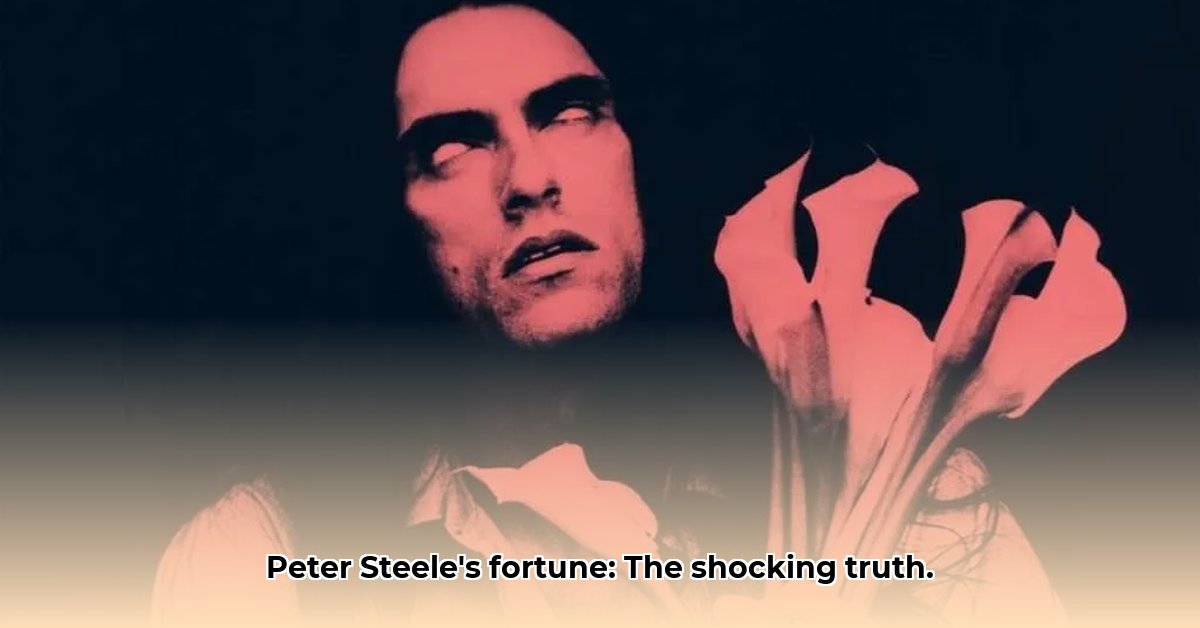
The name Peter Steele conjures images of gothic grandeur, a gravelly voice that could curdle milk, and songs that plumbed the darker depths of the human experience. He was the unmistakable face of Type O Negative, a band that carved a unique niche in the metal world. But how much did this brooding baritone amass? Pinpointing Peter Steele's net worth is a challenge akin to deciphering one of his more cryptic lyrics – a blend of mystery, solid clues, and ultimately, educated guesswork. This isn't about sensationalism, but about exploring the fascinating interplay between his career, personal struggles, and his financial reality. Estimates range wildly, from a mere million to a purported four million dollars. Let's delve into the details and attempt to unravel this enigma. For more on musicians' net worths, check out this resource.
From Carnivore's Raw Thrash to Type O Negative's Gothic Reign: A Musical Empire Takes Shape
To understand Steele's potential wealth, we must trace his musical journey. It began with Carnivore, a thrash metal band that, while not commercially explosive, cultivated a fiercely dedicated following. This laid the groundwork, establishing Steele's powerful vocal presence and unique stage persona. The subsequent formation of Type O Negative marked a pivotal shift. This band catapulted to success, particularly with albums like October Rust and Bloody Kisses. These weren't just critically acclaimed; they sold exceptionally well, propelling Type O Negative into gothic metal's upper echelon. Extensive touring—sold-out venues, fervent fans, and mountains of merchandise—significantly boosted the band's, and consequently Steele's, income. This undoubtedly contributed to his net worth, but the exact amount remains shrouded in mystery. How much did album sales directly contribute to his personal wealth? It's difficult to say.
The Complexities of Musician Finances: Beyond Record Sales
Determining a musician's net worth is far from a simple sum of album sales. It's a complex equation with numerous variables. Royalties from record sales represent only a fraction of the picture. Publishing rights (ownership of the songs themselves), income from countless tours, merchandise sales (those iconic Type O Negative shirts!), and any potential side projects or investments all contribute. Adding to this complexity is Steele's intensely private nature, further obscuring the financial picture.
The Unseen Costs of Addiction and Mental Health Struggles
Steele was candid about his struggles with alcohol and mental health. Such challenges, unfortunately, profoundly impact many artists' careers. These battles can disrupt creativity, derail touring schedules, and generally make financial stability elusive. Precisely how these factors affected Steele's net worth is sadly impossible to quantify. It's a crucial piece missing from the financial puzzle. This highlights a vital point: the impact of personal challenges must be considered when evaluating any artist's financial standing.
A Legacy Etched in Gothic Metal: Beyond the Balance Sheet
Ultimately, Peter Steele's enduring legacy far surpasses any monetary valuation. His influence on gothic metal is undeniable. Type O Negative's distinctive sound—a potent blend of doom metal, gothic rock, and Steele's unforgettable, operatic baritone—created a lasting impact. Countless bands owe a debt to his musical vision and dark, theatrical presentation. He transcended mere musical success; he became a cultural icon. This legacy is immeasurable and far outweighs any attempts to assign a dollar figure to his achievements. Isn't that the true measure of an artist's success? It's a question worth pondering.
The Enduring Enigma: Unanswered Questions and Ongoing Speculation
While the precise figure of Peter Steele's net worth may remain elusive, the attempt to understand it reveals a fascinating portrait of a complex artist who navigated monumental successes alongside deeply personal challenges. He was a master of contradictions: darkly humorous, yet his music explored profound themes of darkness and despair; intensely private, yet his music resonated with millions. This enigma, this mystery, is part of his enduring appeal. He remains a legend, not just for his music, but for the compelling mystery that continues to surround him.
How Did Substance Abuse Impact Peter Steele's Net Worth and Career?
Key Takeaways:
- Steele's unique talent propelled Type O Negative to success, yet his net worth remains a mystery, highlighting the complexities of the music industry.
- His struggles with substance abuse and mental health likely impacted his earning potential and career length.
- Quantifying the financial repercussions of these challenges is difficult, adding to the enigma surrounding his wealth.
- His legacy in gothic metal transcends monetary value, establishing his enduring impact on music.
The imposing figure of Peter Steele, his distinctive baritone, and darkly humorous lyrics remain etched in the minds of metal fans. But how did his personal battles translate into his financial reality? The answer, much like the man himself, is shrouded in mystery.
Type O Negative enjoyed a devoted following, releasing critically acclaimed albums. However, success in the music industry doesn't automatically translate into substantial wealth. The available information regarding Steele's financial status is limited and often contradictory.
The impact of addiction on a musician's career is multifaceted; it can disrupt recording sessions, cancel tours, and damage crucial relationships, all negatively impacting income. How much this affected Steele is conjecture, another piece missing from the overall puzzle.
Beyond finances, Steele's legacy is rich and complex. He left a body of work that continues to influence and inspire. His unique style, darkly comic lyrics, and powerful stage presence cemented his place in music history. This legacy truly is priceless.
While we cannot definitively calculate his net worth, Peter Steele's influence on gothic metal remains undeniable. His story, a blend of triumph and tragedy, illustrates the complex relationship between artistic talent, personal struggles, and the unpredictable nature of the music industry.